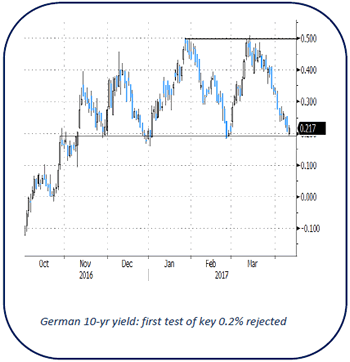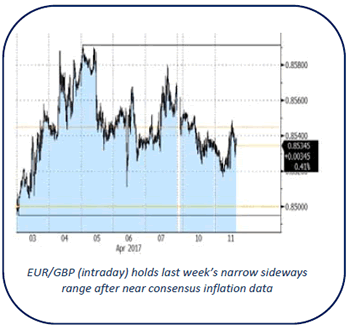Headlines
European stock markets managed to recover most of the opening losses as risk aversion from Asian trading didn’t persist. US stock markets open with small losses as US investors seem to be more afraid about the US’ tougher stance against Syria and North-Korea.
British inflation held steady in March due to the later timing of this year’s Easter holidays which pushed down airfares, and a dip in global oil prices, but the squeeze on households looks set to resume soon. Consumer prices increased in March by 2.3% Y/Y while core CPI declined from 2% Y/Y to 1.8% Y/Y.
EMU industrial output declined in February (-0.3% M/M), against market expectations of a slight increase (0.1% M/M), largely due a sharp drop of energy production. German ZEW-investor confidence rose more than anticipated in April, as Europe’s largest economy continues to gather momentum. The forward looking expectations component also increased further, beating consensus.
US NFIB small business optimism eased off multi-year highs in March, marginally declining in line with expectations from 105.3 to 104.7.
North Korea is "looking for trouble" and the US is prepared to act unilaterally on the issue, with or without China’s support, US President Trump said, as the new administration solidifies its much tougher stance on the Asian country.
US Secretary of State Tillerson said it is clear the regime of President Bashar al-Assad in Syria "is coming to an end" and issued a stern warning to Russia as he headed to Moscow for high-level talks on the crisis. The secretary of state also said that "Russia has failed in its commitment to guarantee a Syria free of chemical weapons."
Rates
Technical losses for Bund, but US investors cautious
German Bunds underperformed US Treasuries today. Risk aversion pushed US Treasuries higher during Asian dealings. The Bund opened stronger as well with an immediate test of key support in the German 10-yr yield (0.2%; lower bound 0.2%-0.5% trading range). The test failed, sending German yields higher and Bunds lower. The move’s technical importance could be similar to Friday’s failed test of key US yields (5y: 1.8% and 10y: 2.3%) if confirmed. European equities managed to recover most of the opening losses and weighed on Bunds as well. Eco data were mixed with disappointing (outdated) industrial production, but a positive surprise from the more important German ZEW investor sentiment. The headline reading hit its highest level in April since the euro crisis, while the forward looking component suggests that strong Q1 growth momentum expands into Q2. The only item on the US eco calendar was NFIB small business optimism, which declined as forecast from 105.3 to 104.7 in March. US Treasuries managed to hold on to most of the overnight gains despite the Bund’s downward bias in European trading. Rising geopolitical tensions (Syria, North Korea) still linger in the background of investors’ minds (see headlines). As the US trading session gets going, core bonds gain momentum as risk sentiment hits a snag. US stocks deepen losses after the opening and USD/JPY is heading to 110.10 support.
At the time of writing, the German yield curve shifts 0.4 bps lower (2-yr) to 0.7 bps (10-yr) higher. Changes on the US yield curve vary between -3.5 bps (10-yr) and -2.4 bps (2-yr). On intra EMU-bond markets, 10-yr yield spread changes versus Germany widen up to 3 bps (Italy; supply-related) with Greece marginally outperforming (-3 bps).
The Austrian Treasury launched a new 10-yr benchmark via syndication (Apr2027). The bond was priced to yield MS -18 bps, compared to MS -17 bps area guidance. Final books closed in excess of €7.5B, allowing the Treasury to print €4.5B. The Dutch debt agency tapped the on the run DSL (€0.95B 2.5% Jan2033). The amount sold was in the lower half of the €0.75-1.25B on offer, but that’s not unusual for Dutch auctions. Tonight, the US Treasury continues its refinancing with a $20B 10-yr Note auction. Currently, the WI trades around 2.34%.

Currencies
Dollar loses ground
The dollar lost ground across the board today. During European trading, EUR/USD recorded the biggest move as the US/EU spread differential narrowed. EUR/USD increased from 1.0580 to an intraday high of 1.0620. The German 10-yr yield bounced off key support (0.2%), pulling the German curve higher. A strong German ZEW investor sentiment might have played a role as well. EMU industrial production (disappointing) and US NFIB small business optimism (spot on consensus) didn’t affect trading. Yesterday’s French bond/stock underperformance (on rising support for extreme-left candidate Mélenchon) didn’t persist and thus didn’t weigh on the single currency.
In the US trading session, USD/JPY took over command. Comments by US secretary of state Tillerson (on Russia/Syria) and by US president Trump (on North Korea) confirmed the US’ recent tougher stance, stressing geopolitical tensions and creating some new risk aversion. USD/JPY slid from levels around 110.70 to 110.20 currently and is gearing up for a new test of key 110.10 support.
The trade-weighted dollar dropped from 101.10 to 100.80 today, erasing the final post-payrolls gains.

Sterling: No firm direction after inflation data
Overnight, the BRC like for like sales disappointed as they dropped 1% Y/Y while a 0.3% M/M decline was expected. It’s a further sign that consumer spending is losing momentum. However, it didn’t impact sterling as investors clearly waited for the important inflation data. At their previous policy meeting, the BoE (MPC) showed they saw little room to let inflation move much higher without tightening policy. However, their concerns proved premature as inflation behaved well in March. The headline CPI was stable and in line with expectations at 2.3% Y/Y, while core CPI eased even slightly more than expected to 1.8% Y/Y from 2% Y/Y previously. Input and output PPI eased in March compared to February, even if they surpassed expectations and remain at a fairly high levels. Only core output PPI was a tad higher. There was a knee-jerk reaction pushing sterling stronger versus euro and dollar. However, the absence of follow through sterling buying caught the eye of sterling bulls and bears. Gains were in no time erased. EUR/GBP currently trades around 0.8540, versus the 0.8535 opening. Cable is marginally higher at 1.2434 versus 1.2415 at the open, the modest rise of EUR/USD being the trigger. EMU data were mixed (see dollar section) and the NFIB small business confidence was in line with expectations. Concluding, a session to rapidly forget














